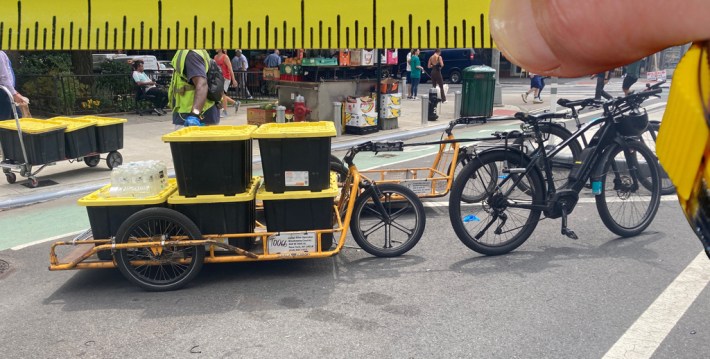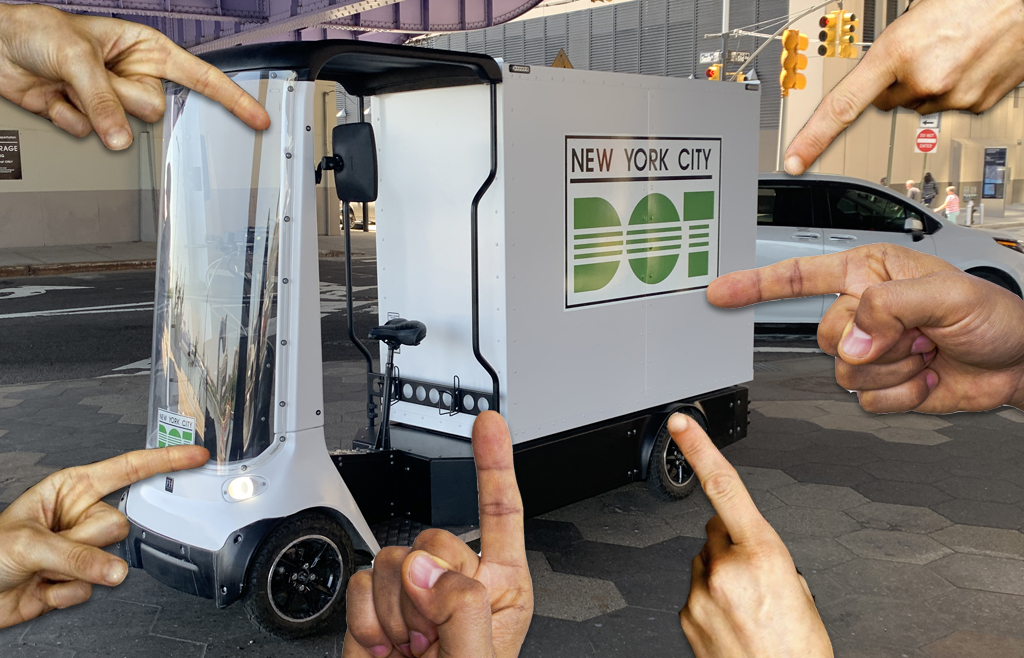This freight bike rule is going to be a heavy lift.
A Department of Transportation tweak of cargo bike rules that the agency says would make the boom in deliveries "safer and more sustainable" was assailed on Wednesday, both by industry officials who said the rules would shackle innovation in an industry on the cusp of growth and by members of the public who feel that unleashing wider, faster, heavier cargo bikes will turn the current "Wild West" roadways of the city into the aftermath of the shootout at the OK Corral.
More than 100 people participated in the rule-making hearing, which is an astounding number for what is a bureaucratic formality. But nothing is a formality when New York's streetscape is concerned.
Cargo bike industry leaders continued their assault on several elements of the proposed rules, especially a cap on the length of bike-and-trailer combos to just 10 feet — which is several feet shorter than the systems used successfully by Amazon and Whole Foods as they make thousands of deliveries every day in the city with a cargo bike fleet that is by far the largest in the city.
"We are astounded that DOT would propose to ban 95 percent of the current cargo bike fleets active in New York City," said Gregg Zuman, who runs Revolution Rickshaws and founded the New York Cyclomobile Association (a trade group). "Banning every cargo bike trailer in use is not an idea that came from anyone currently operating. Ninety-five percent of the equipment is longer than 10 feet today and this includes equipment used by DOT cargo bike pilot participants today."
He advocated for a 20-foot limit.

Zuman's Cyclomobile partner Peter Meitzler also said the DOT should cap cargo bike speeds at 15 miles per hour — which is already three miles per hour above the cargo bike pilot program limit — instead of allowing them to hit 20, as the rules state.
Meitzler also called for something that's not in the rules: Weight limits on cargo bikes, including the 48-inch, 10-foot-high, four-wheeled, pedal-assist versions that the DOT hopes to legalize (pictured at the top of this story). He said that he "applied Newton's second law of motion" to calculate the impact force of a 1,500-pound loaded cargo bike — and determined it would be half the force of a car and nine times the weight of a loaded bike. He called for a 440-pound unloaded weight cap.
In summary, Zuman said that "today's proposed amendments, if fully enacted, on balance would do more harm to the industry than to help it."
Several other industry officials questioned the rules, which was expected. What was unexpected was the silence from Amazon and Whole Foods, which operates the massive fleet of bike-and-trailer tandems to which Zuman alluded. Unfortunately, the company did not testify, nor did it respond to Streetsblog seeking its insight on the rules.
Members of the public also showed up in droves amid the current backlash against all forms of micromobility, turning the public comment period of the hearing into a larger referendum on DOT's overall street safety agenda.

Many of the usual suspects of the anti-bike coalition spoke, but most kept their comments to a widespread perception — shared by pedestrians, cyclists, pro-e-bike activists, policy shops and industry — that roadways are simply less safe right now for the most vulnerable road users.
This referendum focused in part on the new rules that would classify as a "bicycle" the aforementioned four-wheel, pedal-assist "cargo machines," as a woman who gave the name Carrie called them, or "baby box trucks" as Upper East Sider Andrew Fine called them.
Upper West Sider Susan Simon was one of many speakers who noted that the rules allow the newly permitted wide cargo bikes to be parked on a sidewalk "temporarily for the purpose of and while actually engaged commercially in loading and unloading property.” She argued that cargo bike operators would use this loophole to ride on the sidewalk before parking.
"Introducing cargo vans onto the sidewalks of this city will bring an exodus of people like myself who feel we need to be safe in this city from e-bikes, from e-cargo vans and from bicycles," she said. "We are giving our streets over to private profiteers."
Christine Berthet of the venerable pedestrian advocacy group CHEKPEDS noticed that the sidewalk rule change differed from the language in the city's own 2021 Cargo Bicycle Pilot Report, which recommended allowing cargo bikes to load and unload wherever commercial vehicles could, but not on the sidewalk.
Yes, the language of the rule only allows for fast unloading or loading, but Berthet called that "unenforceable" and said it would "set a precedent for all other cyclists" to load and unload on the sidewalk.
But other members of the public broadly diverged from the specifics of the rules to speak about their recent experiences on city roadways, where bike riders and legal e-bike riders are squeezed in bike lanes with illegal mopeds on roads that allocate far too much space to cars.
"There is no way to put a four-foot-wide box on a bike path safely, I'm sorry," Joel Geib. "I like the vehicles, I've seen pictures of them online, I think they should absolutely make them, but they do not belong in bike lanes. It's the end of bike lanes. We can't call them bike lanes anymore if they are open to four-wheel trucks that are electric powered. ... This will end in dead cyclists."
Another cyclist read into the record a recent Streetsblog story about a horrific moped crash in the bike lane on the Manhattan Bridge as evidence of a crisis.
Patricia Bennett, a New Yorker for 24 years, added, "I've never been scared here until now. The sidewalks are not safe because of bikes or whatever we should be calling them."
Unfortunately, no speaker addressed the gravest danger on New York City roads today: cars and especially trucks, whose presence would indeed be reduced by a robust cargo bike industry that the DOT says it is trying to encourage. So far this year, car and truck drivers have been involved in 63,362 reported crashes, or roughly 251 per day, injuring 2,842 cyclists, 5,204 pedestrians and 25,095 other motorists, according to city stats.
Many speakers did address the need to reduce the congestion and carbon footprint of trucks, including advocates and industry experts.
"New Yorkers have increasingly relied on home delivery services, which means more large delivery trucks crowding streets, without corresponding mitigation efforts," said Elizabeth Adams, the deputy director of Public Affairs at Transportation Alternatives, citing the 3.6 million daily packages delivered daily across the city — double from just three years ago.
"The impacts of heavy truck usage are widespread ... subjecting young people to higher rates of asthma and air pollution" as well as low-income neighborhoods to disproportionate truck-related crashes.
"Shifting to smaller cargo bikes not only frees up space on our congested roadways, they improve traffic safety by removing bulky and heavy trucks from the streets," she added.
But for the rules to work, TA recommended more loading zones (to keep cargo bikes off the sidewalk), wider bike lanes to accommodate modes of different speeds and widths, two-way lanes to discourage salmoning, and cargo bike delivery hubs.
For its part, DOT said it was listening intently — to all arguments.
"We look forward to reviewing comments of the dozens of participants we heard from today, safety concerns included," said agency spokesman Scott Gastel. "Please note the intention here is to make our streets safer and more sustainable, when the alternative is not offering alternatives to emission releasing, multi-ton/large trucks."






